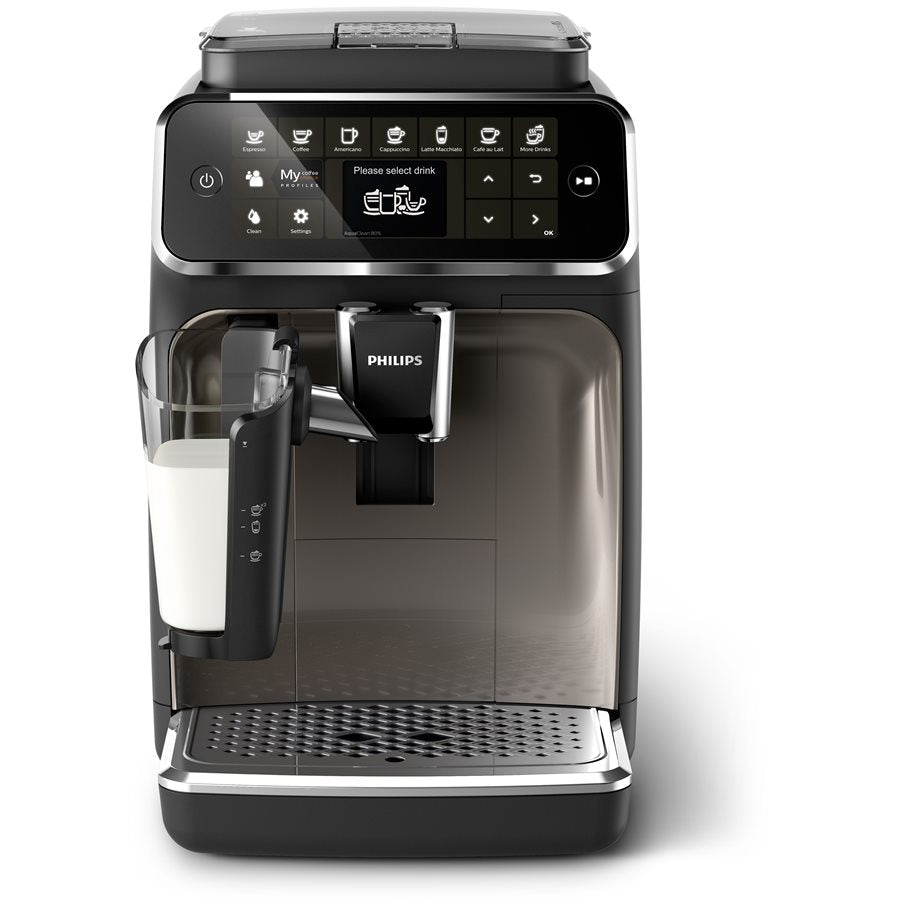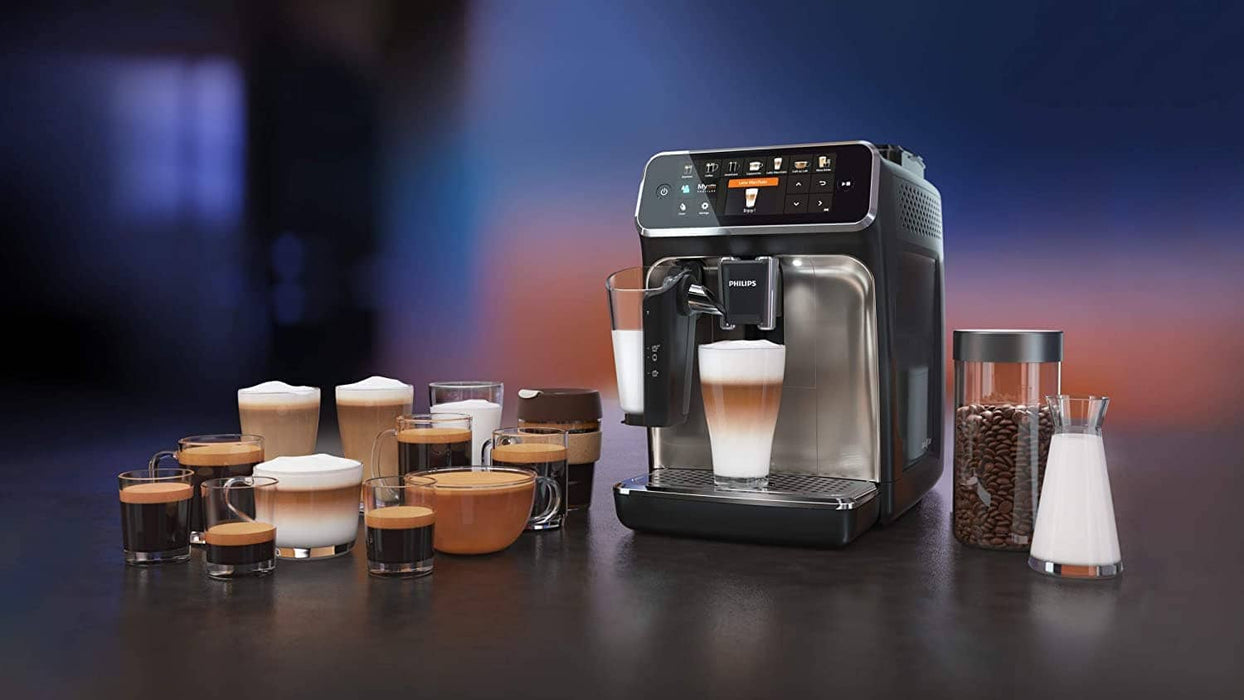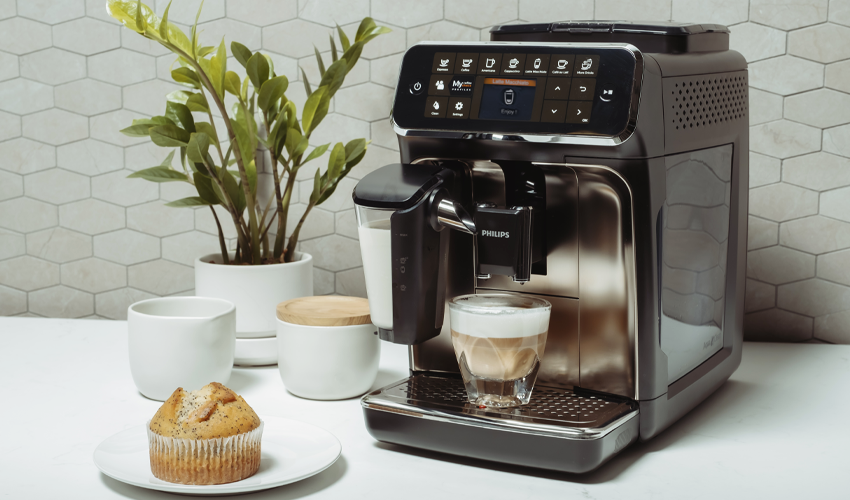#1: Philips LatteGo 5400

- Wide variety of drinks
- Advanced customization
- User profile options
#2: Philips LatteGo 4300

- Basic milk frother
- Small water tank
- Noisy grinder
When I first started looking for a new coffee machine for my home, I knew that I wanted something that would deliver great-tasting coffee with minimal hassle. The task seemed straightforward, but as I started exploring the options, I quickly realized that choosing the right one isn’t as simple as it sounds. After considering various models, I found myself torn between two very popular super-automatic espresso machines from Philips: the LatteGo 5400 and the LatteGo 4300.
Both machines come with plenty of features to make your morning coffee routine a breeze, but there are subtle differences that really set them apart. In this review, I’ll be comparing these two models from the perspective of someone who’s used both, sharing my personal experience with each and why I ultimately found the Philips LatteGo 5400 to be the better choice. Know about Philips company history

Design and Build Quality: How the Machines Stack Up
When I first unboxed both the Philips LatteGo 5400 and the LatteGo 4300, I was immediately struck by how sleek and modern both machines look. The 5400, however, has a slightly more premium feel to it, thanks to its matte black finish with stainless steel accents. It felt sturdy and looked like a high-end appliance, which made it a pleasure to keep on the counter.
In contrast, the 4300 is a bit more utilitarian, made primarily from glossy black plastic. It’s still well-built and durable, but it lacks the same upscale aesthetic that the 5400 offers. I’ll admit that I have a soft spot for a good-looking coffee machine, and the 5400’s design really won me over.
User Interface and Display: The Philips LatteGo 5400 Leads the Way
One of the first things I noticed when using the Philips LatteGo 5400 was how intuitive and easy the interface was to navigate. The machine features a full-color TFT display, which really makes a difference in terms of clarity and ease of use. The icons are large, clear, and easy to understand, which is a huge plus, especially for someone like me who isn’t exactly a tech expert. The display also gives you an overview of all your options and settings, making it a breeze to adjust everything from coffee strength to milk froth levels.
On the other hand, the Philips LatteGo 4300 has a more basic interface. It lacks the color display of the 5400 and has smaller, less intuitive buttons, which made the overall user experience feel a little more clunky. While it still works just fine, I found the simplicity of the 4300 a bit less engaging compared to the sleek, more modern interface of the 5400.
Coffee Quality: Taste and Customization
As someone who enjoys a variety of coffee styles, customization is key for me. Both the 5400 and 4300 deliver great coffee, but there are a few key differences in terms of what’s available and how much you can tailor your brew.
The Philips LatteGo 5400 offers a broader selection of beverages, with 12 pre-programmed drinks including espresso, cappuccino, latte macchiato, flat white, and more. The ability to easily select from such a wide range of options means I can enjoy my favorite drinks without much fuss. Whether I’m in the mood for a strong espresso or a creamy latte, the 5400 delivers consistently excellent results.
The 4300, while also offering a variety of drinks, only has 8 pre-programmed options. It does a great job at delivering quality coffee, but the lack of variety was a bit limiting for me. On top of that, the 5400 lets you adjust the strength, temperature, and volume of your coffee with more precision, which means I can fine-tune my drinks to exactly how I like them. The 4300 offers some customization, but it’s not quite as comprehensive.

Milk Frothing: The LatteGo System Shines in Both Models
If you enjoy milk-based drinks like lattes and cappuccinos, then you’ll appreciate the milk frothing system in both models. The Philips LatteGo technology is brilliant – it creates a smooth, creamy froth with no hassle, and the best part is that the system is easy to clean. Both the 5400 and the 4300 use the same LatteGo frothing system, so they both produce rich, velvety milk foam that enhances the texture of your drinks.
That said, I did notice a slight difference in performance between the two. The 5400’s milk frothing seemed a little more consistent, creating a creamier texture that was perfect for making those coffeehouse-style drinks. It’s a small difference, but it definitely added to the overall coffee experience, especially when I was making drinks like cappuccinos or flat whites. Learn How to fix under extracted espresso
Maintenance: Easy to Clean, but the 5400 Is a Step Ahead
Both machines are designed with ease of maintenance in mind. The LatteGo milk system is incredibly simple to clean – just two parts that can go straight into the dishwasher or be rinsed under the tap. The coffee grounds container, drip tray, and water tank are all easy to access and clean, and the machines remind you when it’s time for a cleaning or descaling cycle.
The Philips LatteGo 5400 has a slight edge here, though, as it provides more detailed maintenance alerts and a more streamlined descaling process. It also includes an AquaClean filter, which reduces the need for frequent descaling, so you can enjoy better-tasting coffee and less maintenance in the long run. The 4300 also includes an AquaClean filter, but I found the process a bit more manual and less intuitive compared to the 5400.

Size and Space Considerations
Both models are fairly compact for super-automatic espresso machines, but the 5400 is a bit larger due to its more advanced features. If you have limited counter space, this could be a consideration, as the 5400 does take up more room. That said, the extra space is justified by the added functionality and customization options.
The 4300, while a bit smaller, is still a substantial machine. If counter space is your primary concern and you don’t need all the bells and whistles that come with the 5400, then the 4300 could be a good choice. For me, though, I found the extra space taken up by the 5400 to be well worth it for the added features.
Price and Value for Money
The price difference between the Philips LatteGo 5400 and the 4300 is definitely something to consider. The 5400 is the more expensive model, but in my opinion, it justifies the extra cost with its wider range of beverage options, better display, and superior customization features. For coffee lovers who want a top-notch coffee experience, the 5400 delivers excellent value for the price.
The 4300, while less expensive, is still a great option. It delivers excellent coffee, has a simple interface, and is perfect for those who don’t need all the advanced features of the 5400. If you’re looking for a more budget-friendly option that still produces high-quality drinks, the 4300 will serve you well.
Product Review Conclusion: Philips LatteGo 5400 vs 4300
After using both the Philips LatteGo 5400 and 4300, I can confidently say that the 5400 is the superior model, especially for those who value customization, a premium design, and a wide range of beverage options. The 5400 excels in providing a more personalized coffee experience, with features like a full-color display, advanced coffee settings, and more drink choices. If you’re someone who enjoys experimenting with different coffee styles and flavors, this machine will not disappoint.
That said, the Philips LatteGo 4300 is still a solid choice for anyone who wants an easy-to-use, reliable machine that delivers great coffee without the extra frills. If you don’t need the added complexity of multiple profiles or extra drink options, the 4300 will give you everything you need to enjoy a delicious cup of coffee.
Ultimately, both machines are fantastic options, but the Philips LatteGo 5400 stands out in terms of features, ease of use, and coffee quality. Whether you’re a coffee enthusiast or just looking for a convenient way to brew your daily cup, the 5400 is well worth considering.
Frequently Asked Questions (FAQ) about Philips LatteGo 5400 vs 4300
Q1: What is the main difference between the Philips LatteGo 5400 and 4300?
A1: The main difference is the range of features and customization options. The Philips LatteGo 5400 offers 12 pre-programmed drinks, more customization options for coffee strength, temperature, and volume, and a full-color TFT display. The 4300, while still a great machine, has 8 pre-programmed drinks and a more basic user interface.
Q2: Is the milk frothing system the same on both models?
A2: Yes, both the Philips LatteGo 5400 and 4300 use the LatteGo milk frothing system, which creates creamy and smooth milk foam. The difference is subtle, with the 5400 producing slightly creamier froth, but both systems are easy to clean and deliver excellent results.
Q3: Does the Philips LatteGo 5400 allow for more coffee customization than the 4300?
A3: Yes, the 5400 provides more customization options. You can adjust the coffee strength, volume, and temperature for a more personalized coffee experience. Additionally, the 5400 supports up to four user profiles, while the 4300 only supports two.
Q4: Is the Philips LatteGo 5400 easier to use than the 4300?
A4: The Philips LatteGo 5400 is generally easier to use, thanks to its full-color TFT display and intuitive interface. It provides clear icons and navigation for selecting drinks, adjusting settings, and performing maintenance. The 4300’s interface is simpler, but some users may find it less engaging.
Q5: How do the cleaning and maintenance processes compare between the two models?
A5: Both models are designed for easy maintenance. The LatteGo milk system is simple to clean with two parts that can be rinsed under the tap or placed in the dishwasher. The 5400 offers more detailed maintenance alerts and a more streamlined descaling process compared to the 4300, but both models include AquaClean filters to reduce the need for frequent descaling.
Q6: Which model is better for someone who is new to using a super-automatic espresso machine?
A6: The Philips LatteGo 5400 might be a better choice for beginners, especially if you're looking for a more user-friendly interface with a clear display and easy-to-navigate settings. It also offers a wider range of drink options, which is helpful for experimenting with different types of coffee.
Q7: Is there a significant price difference between the Philips LatteGo 5400 and 4300?
A7: Yes, the Philips LatteGo 5400 is priced higher than the 4300 due to its additional features, including the full-color display, more drink options, and increased customization. However, the 4300 is still a great value for its price, delivering excellent coffee quality at a more affordable price point.
Q8: Can I make specialty drinks like lattes and cappuccinos on both machines?
A8: Yes, both machines are capable of making specialty drinks like lattes and cappuccinos thanks to the LatteGo milk frothing system. The 5400 offers slightly more customization, such as stronger or lighter milk froth, which can enhance your experience when making these drinks.
Q9: How long do the Philips LatteGo machines last?
A9: With proper care and maintenance, both the Philips LatteGo 5400 and 4300 are built to last for many years. The ceramic grinders, durable build quality, and AquaClean filters contribute to their long lifespan. Regular cleaning and descaling are key to ensuring the machines perform well over time.
Q10: Is the Philips LatteGo 5400 worth the extra cost?
A10: For coffee enthusiasts or anyone who values a more customizable coffee experience, the Philips LatteGo 5400 is worth the extra cost. It offers a wider variety of drinks, more personalization options, and a premium design. However, if you're looking for a simpler machine that delivers great coffee without the bells and whistles, the 4300 is a more affordable option that still performs excellently.
